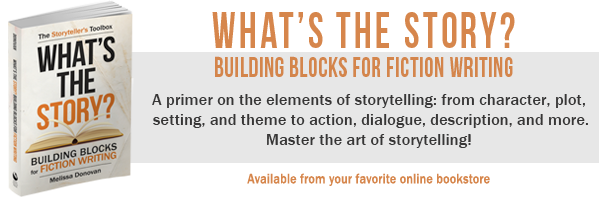Today’s post includes excerpts from What’s the Story? Building Blocks for Fiction Writing, chapter six: “Narrative Point of View.” Enjoy!
The terms story and narrative can be used interchangeably, meaning a sequence of events, real or fictional, that are conveyed through any medium ranging from prose to film. However, when we talk about narrative, we’re often referring to the structural nature or presentation of a story, the manner in which it’s told.
Narrative Point of View
The narrator of a story is the in-world storyteller, the voice that imparts the story events to the audience. Narrative point of view, often called POV, determines the position of the narrator, relative to the story. Points of view include first person, second person, and third person.
If readers envision the events of a story as a movie playing in their minds, then the narrative point of view is best described as where the camera is sitting at any given time. In the case of first-person point of view, the camera is inside the narrator’s head; we see the story through their eyes. In limited third-person point of view, the camera sits on one character’s shoulder; that character is not telling us the story, but we’re close to their perspective of events. In omniscient third-person point of view, the camera is pulled back so it can capture everything in the story objectively.
First Person
In a first-person narrative, the narrator is a character within the story—often (but not always) an active participant. First-person point of view is easily identified by the narrator’s use of I or we. It’s often told from the point of view of the protagonist. The Catcher in the Rye is an example of a first-person narrative told from the protagonist’s perspective. However, first-person narrative can also be relayed by a secondary or tertiary character, such as when the narrator is a witness to the story events rather than an active participant. In the case of a story such as Heart of Darkness, the first-person narrator is relaying a story as told to him by someone else.
The first-person point of view provides ample opportunities to present a narrator with a distinct voice, which flavors the story’s tone, giving it personality and a subjective slant. For this reason, first-person narration can feel more intimate, as if the reader is in a close conversation with the storyteller. First person often feels as if we’re inside the narrator’s head. When executed well, this helps readers forge deep and lasting connections with the character and the story.
First person is ideal for stories that need to explore the narrator’s internal thoughts and emotions. However, first-person narrative comes with interesting limitations, such as when the narrator is not privy to what other characters are thinking, feeling, or doing. Because some stories require that readers know what other characters are thinking and doing, first-person narration is not always appropriate.
First-person narration is frequently used in all genres of fiction and is especially common in the nonfiction categories of memoir and autobiography.
Second Person
Second-person narratives use second-person personal pronouns (you) to refer to other characters or the reader. These stories often feel like the narrator is talking to the reader as if the reader is the main character in story. We tend to see second-person point of view used mostly in instructions (“After you dip the apples in caramel, set them on wax paper to harden.”). This point of view is rarely used in storytelling. Bright Lights, Big City is one of the rare novels written in second person. Here’s an excerpt:
You keep thinking that with practice you will eventually get the knack of enjoying superficial encounters, that you will stop looking for the universal solvent, stop grieving. You will learn to compound happiness out of small increments of mindless pleasure.
Third Person
Third-person point of view is the most common form of prose narrative because it offers the greatest flexibility with access to all characters and full view of the story world and all events taking place. Even limited third-person narratives offer broader access to the story’s full scope than a first-person narrative. Characters are referred to as he, she, and they. There is no I or you. The narrator is not a person but an entity.
Third-person narratives are categorized on two axes: subjective/objective and omniscient/limited.
Third-person subjective allows the narrator to describe characters’ thoughts and feelings using internal dialogue. Third-person objective does not have access to characters’ thoughts and feelings; it only offers an external view of the characters. Many narratives float in and out of subjective and objective, giving readers glimpses of the characters’ thoughts when it benefits the story and keeping the characters’ thoughts hidden when doing so serves the story.
A third-person omniscient narrative has full view of the story and characters at all times. The narrator knows everything in the story world but may choose which details to reveal to the reader. A third-person limited narrative only has full knowledge of one character and can only relay events that character is privy to.
Narrative point of view is an important consideration for any storyteller, because it helps orient readers in the story world by giving them a distinct perspective from which they observe the story events unfolding.
Want to learn more about narrative point of view? Pick up a copy of What’s the Story? Building Blocks for Fiction Writing.






Very good article, explaining it well, thank you.
You’re welcome, Adele. Thanks for commenting.
Thank you for your explanations. Made it easy to understand.
You’re welcome!
For years I used a third person narrative. It makes everything straightforward and easy. I used first person narratives only in short stories where it could be contained. Then when writing a short story in the first person it became a long story. I am sure that you have all been there at some point. Then it becomes difficult. All motivations are guessed as unless the person tells you something all you have to go on are words and actions. It presents many difficulties but now I love it.
I think it’s a fun exercise to choose a scene that is written in third person and rewrite it in first person, and vice versa. There are many reason to choose a particular point of view. Some stories will work better in a certain point of view. Some authors write better or feel comfortable in one point of view or another. It’s all quite interesting.